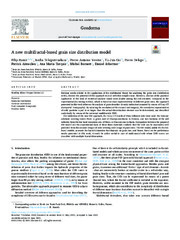Приказ основних података о документу
A new multifractal-based grain size distribution model
| dc.creator | Stanić, Filip | |
| dc.creator | Tchiguirinskaia, Ioulia | |
| dc.creator | Versini, Pierre-Antoine | |
| dc.creator | Cui, Yu-Jun | |
| dc.creator | Delage, Pierre | |
| dc.creator | Aimedieu, Patrick | |
| dc.creator | Tarquis Alfonso, Ana Maria | |
| dc.creator | Bornert, Michel | |
| dc.creator | Schertzer, Daniel | |
| dc.date.accessioned | 2024-01-08T08:42:12Z | |
| dc.date.available | 2024-01-08T08:42:12Z | |
| dc.date.issued | 2021 | |
| dc.identifier.issn | 0016-7061 | |
| dc.identifier.issn | 1872-6259 | |
| dc.identifier.uri | https://grafar.grf.bg.ac.rs/handle/123456789/3366 | |
| dc.description.abstract | Previous works related to the application of the multifractal theory for analyzing the grain size distribution (GSD), showed the potential of this approach to deal with this complex issue. However, absence of the practical application of this kind of statistical analysis raised some doubts among the soil scientists. Compared to the experimental dry sieving method, which is based on mass representations of different grain sizes, the approach presented in this work relies on the analysis of grain densities (density indicators) scanned by means of X-ray CT (Computed Tomography). By reducing the resolution of the scanned soil image(s), the cumulative representation of solid particles equal to or larger than the actual discretization element can be determined, and described analytically by means of the universal multifractals (UM). For validation of the new UM approach, the X-ray CT results of three different soils were used: the volcanic substrate covering Green Wave (a green roof of Champs-sur-Marne in France), and two horizons of the soil collected from the low land mountain area of Sierra de Guadarrama in Spain. Comparison between the proposed UM model and the experimental data of these three materials confirms that the GSD can be reasonably well predicted from the scanned images of soils covering wide range of grain sizes. The UM model, unlike the fractal-based models, accounts for fractal dimension that depends on grain size, and hence, based on the preliminary results presented in this work, it could be rather useful in case of multi-modal soils whose GSD curves are described with multiple fractal dimensions. | sr |
| dc.language.iso | en | sr |
| dc.publisher | Elsevier | sr |
| dc.rights | openAccess | sr |
| dc.rights.uri | https://creativecommons.org/licenses/by-nc-nd/4.0/ | |
| dc.source | Geoderma | sr |
| dc.subject | grain size distribution | sr |
| dc.subject | multifractals | sr |
| dc.subject | X-ray computed tomography | sr |
| dc.subject | granular media | sr |
| dc.title | A new multifractal-based grain size distribution model | sr |
| dc.type | article | sr |
| dc.rights.license | BY-NC-ND | sr |
| dc.citation.issue | 3-4 | |
| dc.citation.rank | M21 | |
| dc.citation.volume | 404 | |
| dc.identifier.doi | 10.1016/j.geoderma.2021.115294 | |
| dc.identifier.fulltext | http://grafar.grf.bg.ac.rs/bitstream/id/12584/Stanic_et_al_2021_geoderma.pdf | |
| dc.type.version | publishedVersion | sr |

